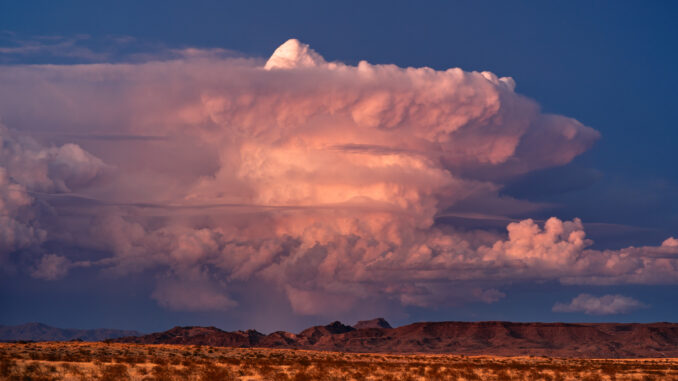

Bryan Fischer, Curator and Horticulturist, Gardens on Spring Creek
Growing up on the Front Range, hearing someone mention “the monsoon is starting” was always welcome. A respite from the intense, Colorado sun and searing summer high temperatures, this shift in precipitation patterns often provided significant cooling and rain during otherwise crispy afternoons. The shift in wind patterns made for some great thunderstorms, too.
The North American monsoon is the result of a few changes in weather patterns that occur simultaneously, typically in early to late summer depending on the region of the American west one is describing. As the sun warms the desert SW and Mexico, air over that region rises. Moisture-rich air from the Pacific and the Caribbean moves in to replace this rising air. This moisture is then carried north and east around an area of high pressure that develops over the southern Great Plains, delivering water to the Four Corners region. Newer evidence suggests the topography of the Sierra Madre mountains may play a role, but space doesn’t allow for such discussion here.
The result of this setup is afternoon and evening thunderstorms that typically dissipate by the next morning. Crucial to plant life in the region, they provide a significant portion of the region’s total moisture. Many plants we think of as desert plants today have actually evolved to capitalize on this fairly reliable, seasonal moisture pulse.
Monsoonal moisture also provided a crucial portion of the water required to grow traditional crops and rangeland grasses in these regions. Beans (another kind of pulse), corn, squash, and amaranth domesticated in this region by indigenous peoples all have some degree of reliance on the monsoon. Requiring very little supplemental irrigation, the tepary bean (Phaseolus acutifolius) is a lesser-known bean native in the region that is planted as the summer monsoon begins. Adapted to produce a crop with less than 16 inches of annual precipitation, the plant is exceptionally drought-tolerant.
Monsoonal adaptations are common in ornamental plants originating from the Southwest, as well. Perennials originating in the Sky Island Mountains of Arizona have been proven to wait for monsoonal moisture before initiating their seasonal bloom. We recognize many of these plants in our gardens today; Epilobium (Zauschneria) spp. (hummingbird trumpet), Agastache rupestris (sunset hyssop), and Datura wrightii (sacred datura; angel’s trumpet) all hail from this range. Making great garden plants due to their tolerance to both heat and cold, these plants also fill a niche in our gardens that can be challenging to color with their late-summer blooms. Since the monsoon is more pronounced to our south, we don’t see many plants native to Larimer County that have such rich late-season growth and bloom. It is worth noting that these plants perform best with some irrigation during years with a weak monsoon since they are adapted to receive some water during mid-late summer.
While we may not receive monsoonal moisture to the degree that Southern Colorado or New Mexican gardens might, the weather pattern still plays a major role in our climate and garden cycle. Occasional afternoon showers and cooling from the second week of July to the end of August can create valuable planting and seeding opportunities in our gardens, but only if one is aware of their likelihood! So, as our monsoon kicks in, consider how you might want to capitalize on it!
Support Northern Colorado Journalism
Show your support for North Forty News by helping us produce more content. It's a kind and simple gesture that will help us continue to bring more content to you.
BONUS - Donors get a link in their receipt to sign up for our once-per-week instant text messaging alert. Get your e-copy of North Forty News the moment it is released!
Click to Donate
